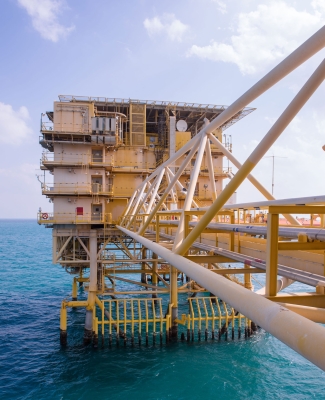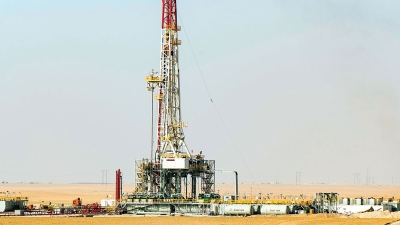
Ras Tannurah Refinery is a giant refinery that Saudi Aramco initiated during the early stages of oil production. The town of Ras Tannurah, situated on the shore of the Arabian Gulf, approximately sixty-four km from Dhahran in the Kingdom of Saudi Arabia, bore witness to the company's work initiation when, on May 1, 1939, the tanker D.G. Scofield anchored there. The Founding King Abdulaziz Bin Abdulrahman Al Saud, personally turned the valve to load the first export shipment of crude oil from the Kingdom.
Beginning of Ras Tannurah Refinery work
The initial refinery was established in Ras Tannurah in 1940 with a production capacity of three thousand barrels per day. However, it closed only six months after its opening due to shortages of manpower and equipment to support the refinery’s operations, caused by World War II.
Work at the refinery began in 1941, and the arrival of the iron shipment in 1944 was the reason for Ras Tannurah’s transformation into a center for industrial activity, coinciding with the start of work on establishing a new main refinery. In 1945, the refinery began operating, and it was transformed from a 'small' refinery into a facility with a refining capacity of 58,000 barrels per day. After the end of World War II, by 1949, a new refinery was built, raising production capacity to 127,000 barrels per day.
Ras Tannurah Port, which includes the artificial island, the southern pier, the northern pier, and the Juaymah crude terminal, is the largest crude oil export port in the world.
Ras Tannurah Refinery activities
In addition to infrastructure development work, the refinery’s activities continued to grow. The first shipment of liquefied petroleum gas was exported on a tanker from Ras Tannurah in 1961. Then, in 1966, work began on the crude oil loading facility represented by the artificial island with two berths, which was built to receive the largest floating tankers, off Ras Tannurah. In 1981, a record was set in shipments from Ras Tannurah as shipments of crude oil and petroleum products exceeded one billion barrels per year for the first time.
Improvements and development work at Ras Tannurah Refinery did not cease with the advancement of the company's business. This period also saw significant expansions in refinery, refining, and transportation works. The year 1999 witnessed the completion of the refinery development project in Ras Tannurah. This enhanced the production of high-value products derived from crude oil.
Characteristics of Ras Tannurah Refinery
Ras Tannurah Refinery continued its constant development through the establishment of expansions and enhancements to its facilities, ultimately becoming one of the largest refineries in the Middle East. On April 11, 1999, during a visit by King Abdullah Bin Abdulaziz Al Saud, who was the crown prince at that time, to Ras Tannurah, he inaugurated a project aimed at upgrading its refineries. This led to an increase in its refining capacity, reaching 550,000 barrels per day of crude oil and condensates.
Production capacity of Ras Tannurah Refinery
Ras Tannurah Refinery is the largest in the Middle East, with a refining capacity of 550,000 barrels per day. It produces daily the equivalent of two thousand barrels of diesel, 180,000 barrels of gasoline, 25,000 barrels of jet fuel, and 25,000 barrels of natural gas liquids. These products cover approximately 40 percent of the Kingdom's needs, which confirms the critical importance of the refinery. The refinery is supported by a control center that directs over two thousand cargo ships annually from around the world, which are received and docked at Ras Tannurah and Juaymah terminals.
Sample laboratory at Ras Tannurah Refinery
Within the Ras Tannurah Refinery, the advancement of operational technologies is closely intertwined with the enhancement of the capabilities of national human resources and their qualification. Through the refinery's sampling laboratory, which stands as one of the largest in the world, Saudi youth are diligently working around the clock to develop production and test samples, ensuring the quality of the production. This is crucial in maintaining the reliability of Saudi oil and the excellence of its products while also offering technical support to the refinery's oil refining plants.
This laboratory is considered the oldest Saudi Aramco laboratory in the field of quality assurance and control, having been established in 1940. It boasts the most diverse array of analysis types and the largest number of automated analysis devices related to the oil industry.
The laboratory is divided into four units and three groups: a unit for detecting the physical properties of crude oil and its derivatives, a water analysis unit, and a gas analysis unit. The fourth unit is the technical support unit, which works to maintain the laboratory and provide all requirements necessary to operate the laboratory. The groups are: Quality Group, Technology and Development Group, and Petroleum Products Control Group.
The laboratory has approximately 589 automated analyzers and uses 132 statistical charts to monitor their performance. Nearly 'thirty thousand digital readings' is the total production of Ras Tannurah Laboratory, through monthly analyses conducted by Saudi Aramco.
Maintenance Operations Simulation and Training Center
Within the context of the ongoing expansion and modernization of the Ras Tannurah Refinery facilities, the Maintenance Operations Simulation and Training Center for the refineries and natural gas liquids fractionation sector was launched on January 5, 2015. It is distinguished by containing simulators that replicate the working conditions inside the laboratories, enabling the training of operators to perform operational tasks and technicians to conduct maintenance work safely. Additionally, it facilitates knowledge transfer between different generations of the company.
The multi-purpose simulation and training center was developed to enhance the skills and confidence of young engineers, technicians, and operators in performing work tasks, as well as to facilitate exploration, repair, and operation of Saudi Aramco facilities. The training center develops employee skills in eight specializations: Operations control engineering, mechanical engineering, electrical engineering, digital device specialist technicians, control systems specialist technicians, electrical technicians, internal control operators, and field operators.
The center consists of several simulation devices for these various specializations at Saudi Aramco. Inside these devices, air is used as a substitute for crude oil and gas. These devices provide an integrated understanding of the real devices used in the laboratories, their operational cycles, various malfunctions, and methods and steps for addressing and repairing these malfunctions.
Giant naphtha splitter column at Ras Tannurah
In October 2019, the clean fuel project team at Ras Tannurah Refinery completed the installation of the largest column in the project, weighing a total of 544 t and measuring sixty-five m in length. This column is utilized for naphtha splitting and serves as the main feeder for the largest isomerization and continuous catalytic reforming units for heavy naphtha, boasting a total processing capacity of 155,000 barrels per day. Its role is also to split the hydrotreated naphtha into light and heavy naphtha, a key function of the Naphtha Hydrotreating Unit, as it controls the benzene precursors, which are then sent to the isomerization unit.
The naphtha splitter column was manufactured by a local Saudi company in al-Jubayl, and the complete manufacturing of the column took more than twelve months, totaling over 2,500 hours.
The clean fuel project for the Ras Tannurah Refinery aims to deliver consumer petroleum products, including automobile fuel, diesel, and various other products, meeting high-quality specifications in compliance with European standards (Euro 5). This initiative involves the establishment of new, state-of-the-art technology factories within the refinery, which is recognized as the largest of its kind globally, to produce clean fuel.
Related quizzes

